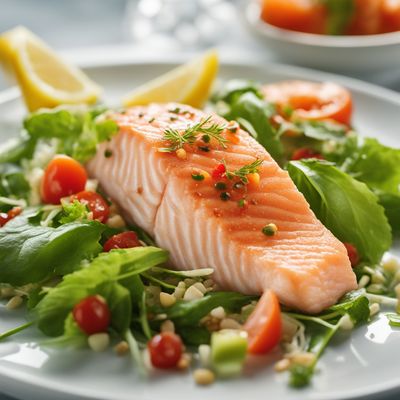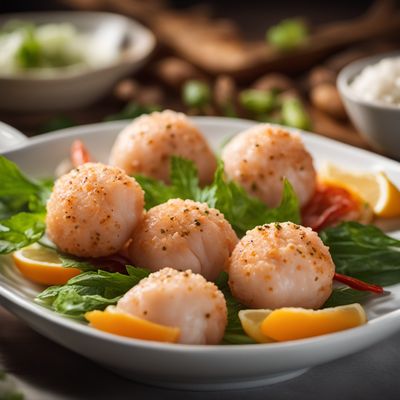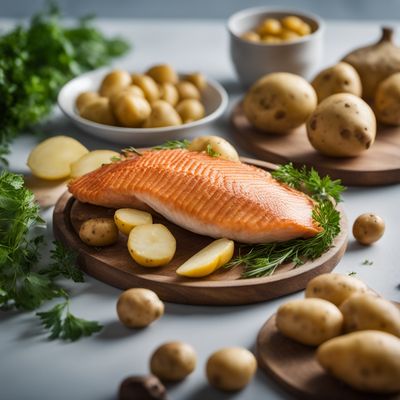
Ingredient
Seafood salad
Ocean Delight
Seafood salad is a vibrant medley of fresh seafood, such as shrimp, crab, and calamari, tossed with a colorful assortment of vegetables like bell peppers, cucumbers, and cherry tomatoes. The combination of tender seafood, crunchy vegetables, and zesty dressing creates a delightful texture and flavor explosion in every bite.
Origins and history
Seafood salad has a long history rooted in coastal regions around the world, where access to fresh seafood has been abundant. It has become a popular dish in many cultures, often served as an appetizer or a light main course. The use of different seafood and vegetables may vary depending on the region and local culinary traditions.
Nutritional information
Seafood salad is a nutritious choice, rich in lean protein, omega-3 fatty acids, vitamins, and minerals. It is low in calories and fat, making it a healthy option for those watching their weight or looking to incorporate more seafood into their diet.
Allergens
Seafood salad may contain allergens such as shellfish, particularly shrimp and crab, which can trigger allergic reactions in some individuals. It is important to be cautious and check for any specific allergies before consuming this dish.
How to select
When selecting seafood for the salad, opt for fresh, high-quality ingredients. Look for firm and glossy seafood with no signs of discoloration or strong fishy odor. The shells of shellfish should be intact, and the flesh should be translucent and moist. For vegetables, choose crisp and vibrant ones that are free from blemishes or wilting.
Storage recommendations
To maintain the freshness of seafood salad, store it in an airtight container in the refrigerator. Consume it within 1-2 days to ensure optimal taste and quality. Keep the dressing separate and add it just before serving to prevent the salad from becoming soggy.
How to produce
Seafood salad can be produced by sourcing fresh seafood from reputable fishmongers or seafood markets. Alternatively, one can catch their own seafood if they have the necessary skills and access to the sea. Growing vegetables for the salad can be done in a home garden or obtained from local farmers.
Preparation tips
To prepare seafood salad, start by cooking the seafood until it is tender and fully cooked. Then, chop the vegetables into bite-sized pieces and prepare the dressing by combining citrus juice, vinegar, herbs, and seasonings. Toss the seafood and vegetables together in a bowl, drizzle with the dressing, and gently mix until well coated. Serve chilled and garnish with fresh herbs or lemon wedges for an extra burst of flavor.
Culinary uses
Seafood salad is a versatile dish that can be enjoyed on its own as a light meal or served as an appetizer. It is commonly featured in seafood buffets, summer picnics, and coastal-themed gatherings. Additionally, it can be used as a filling for sandwiches or wraps, or even as a topping for crackers or crostini.
Availability
Seafood salad is commonly available in coastal regions and areas with access to fresh seafood. It is particularly popular in countries like the United States, Italy, Spain, and Japan, where seafood is a significant part of the local cuisine.
More ingredients from this category

Fish and rice meal
A Nutritious Fusion

Fish gratin
Creamy Seafood Delight: A Delectable Fish Gratin Recipe

Prepared fish salad
Oceanic Delight

Fishcakes
Savory Sea Delights

Bouillabaisse
The Quintessential Seafood Stew

Fish and vegetables meal
Oceanic Delight: A Nutrient-Rich Fusion of Fish and Fresh Vegetables

Seafood-based meals
The Bounty of the Ocean: Seafood-based Meals

Fish pâté
The Delicate Delight of Fish Pâté

Fish balls
The Savory Delicacy from the Sea

Fish and potatoes meal
A Seafood Delight: Fish and Potatoes